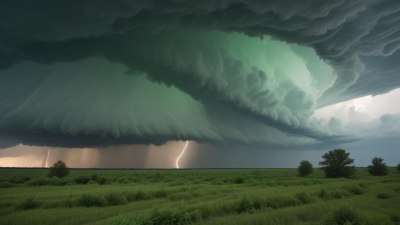Why Some Raindrops Are Bigger
Explore the science behind the size of raindrops and why they vary in size during rainfall.

Image by ojosujono96 on Freepik
Raindrops come in all shapes and sizes, but why are some drops bigger than others? This phenomenon is not merely a quirk of nature; it is a result of several scientific principles that govern the formation and properties of precipitation. Understanding the size of raindrops involves delving into meteorological processes, the physics of water, and the atmospheric conditions that give rise to rain. In this article, we will explore the various factors that contribute to the size of raindrops and uncover the scientific reasoning behind the diverse sizes we see during a rainstorm.
The Formation of Raindrops
Raindrop formation begins in the atmosphere when water vapor condenses around tiny particles known as aerosols. These aerosols serve as the nuclei for cloud droplet formation. Initially, the droplets are microscopic, typically only a few micrometers in diameter. As more water vapor condenses around these droplets, they grow larger. The size of the raindrops is primarily influenced by the atmospheric conditions, including temperature, humidity, and the presence of strong updrafts within the clouds.
Cloud Composition and Droplet Growth
Clouds consist of countless water droplets, and their collective behavior plays a critical role in determining the size of raindrops. In a typical cloud, there are many small droplets along with larger ones. The process of collision and coalescence occurs when smaller droplets collide and merge with larger ones. This can lead to the formation of larger raindrops. The more turbulence present in the cloud, the more collisions occur, leading to an increase in the size of some droplets.
Factors Influencing Raindrop Size
A variety of factors contribute to the size of raindrops, including:
- Updrafts: In storm clouds, strong updrafts can lift smaller droplets, allowing more time for them to collide with other droplets and grow larger.
- Humidity: High humidity levels promote greater droplet growth as more water vapor is available for condensation.
- Temperature: Warmer air can hold more moisture, impacting the formation of larger droplets.
- Wind Shear: Differences in wind speed and direction can influence how droplets collide and coalesce.
Different Types of Rainfall
The type of rainfall can also impact raindrop size. There are generally three types of precipitation: stratiform, convective, and orographic. Each type has distinct characteristics that influence the size of raindrops:
- Stratiform Rain: This type of rain is usually gentle and steady. It generates smaller raindrops due to the gradual formation of droplets in stable atmospheric conditions. The droplets may rarely exceed 1-2mm in diameter.
- Convective Rain: Convective clouds form due to rising warm air and can produce intense precipitation. This rainfall often features larger raindrops, as the updrafts help droplets gain size through collision and coalescence, resulting in drops that may reach 5mm or more.
- Orographic Rain: This occurs when moist air is forced to rise over mountains. The drops tend to vary considerably in size depending on the strength of the wind and humidity in the air.
The Physics of Raindrop Size
Physicists have conducted numerous studies to understand the dynamics of raindrop size. One such study found that the maximum size of raindrops is limited by gravitational and aerodynamic forces. As raindrops grow, they become heavier, which counteracts the buoyant forces keeping them suspended in the air. Eventually, a drop will reach a critical size where aerodynamic drag becomes significant, causing the drop to break apart rather than continue growing. This phenomenon is why raindrops tend to have a diameter of about 0.5 to 6mm.
The Role of Surface Tension
Surface tension is another critical factor that impacts raindrop size. It is the elastic tendency of a fluid surface that makes it acquire the least surface area. The interplay between surface tension and gravity defines the shape and size of raindrops. Smaller droplets are spherical due to the cohesive forces of surface tension, while larger drops flatten out slightly as they fall due to the interaction with air resistance. Ultimately, surface tension plays a crucial role in the formation of raindrops during condensation.
Real-World Implications of Raindrop Size
The varying sizes of raindrops have real-world implications beyond their aesthetic appeal. For example, the size of raindrops can influence the rate of soil erosion, water absorption, and even the health of ecosystems. Additionally, raindrop size can impact weather phenomena, including thunderstorms and flood events. Understanding the complexity of raindrop size can help scientists improve rainfall prediction models and better prepare for the consequences of severe weather.
In summary, the size of raindrops is a multifaceted phenomenon influenced by various atmospheric conditions, cloud dynamics, and physical laws. As we continue to study the science of raindrops, we gain a deeper appreciation for the intricate systems that govern our weather. Whether you are watching a gentle drizzle or a torrential downpour, the size of each raindrop tells a story about the processes occurring in our atmosphere.











